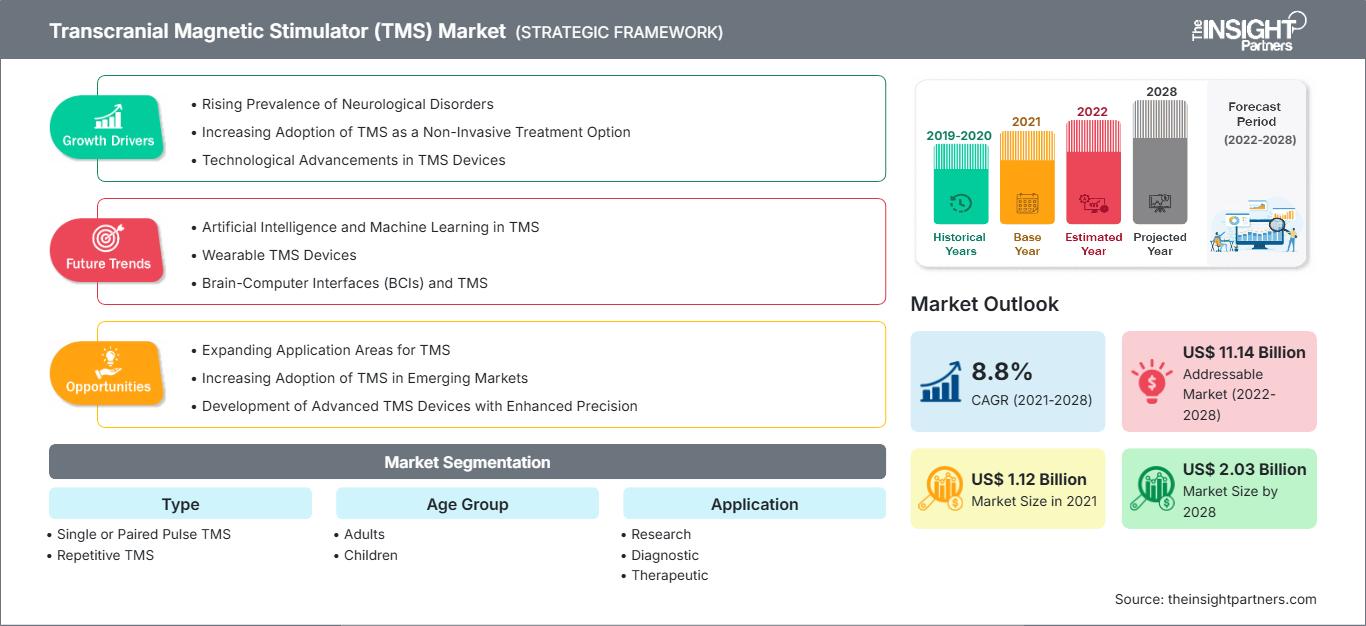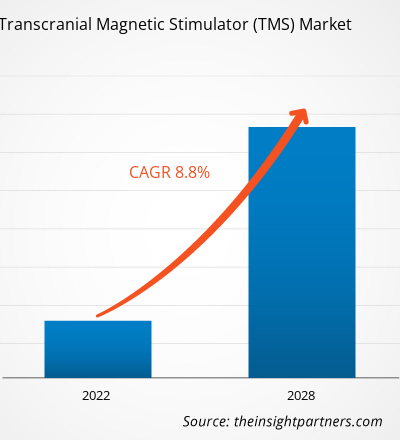[Forschungsbericht]Der Markt für transkranielle Magnetstimulatoren (TMS) soll von 1.122,22 Millionen US-Dollar im Jahr 2021 auf 2.029,71 Millionen US-Dollar im Jahr 2028 anwachsen; von 2021 bis 2028 wird eine durchschnittliche jährliche Wachstumsrate (CAGR) von 8,8 % erwartet.
Neurologische Erkrankungen beeinträchtigen das Gehirn und die Nerven des menschlichen Körpers und verursachen unter anderem Epilepsie und Krampfanfälle, Parkinson, Demenz, Autismus, Alzheimer, Hirntumore und Zerebralparese. Die Prävalenz neurologischer Erkrankungen nimmt weltweit zu. Laut der Global Burden of Disease Study (GBD) 2017 waren Alzheimer und andere Demenzerkrankungen [2,55 Millionen behinderungsbereinigte Lebensjahre (DALYs)], Schlaganfall [ca. 3,58 Millionen DALYs] und Migräne (ca. 2,40 Millionen DALYs) gemessen an der Gesamtzahl behinderungsbereinigter Lebensjahre die drei belastendsten neurologischen Erkrankungen in den USA.
Darüber hinaus schätzt die Alzheimer's Association, dass über 6 Millionen Amerikaner an Alzheimer leiden und diese Zahl bis 2050 voraussichtlich auf fast 13 Millionen ansteigen wird. Die transkranielle Magnetstimulation (TMS) wird häufig zur Diagnose und Behandlung neurologischer Erkrankungen eingesetzt. Laut BrainsWay Ltd. wurden beispielsweise im April 2021 weltweit 100.000 Patienten mit der Deep TMS des Unternehmens behandelt. Die zunehmende Verbreitung neurologischer Erkrankungen treibt das Wachstum des Marktes für transkranielle Magnetstimulatoren (TMS) weltweit voran. Depressionen zählen zu den weltweit am häufigsten auftretenden psychischen Störungen. Laut den im Januar 2020 von der WHO veröffentlichten Daten leiden weltweit mehr als 264 Millionen Menschen aller Altersgruppen an Depressionen.
Passen Sie diesen Bericht Ihren Anforderungen an
Sie erhalten kostenlos Anpassungen an jedem Bericht, einschließlich Teilen dieses Berichts oder einer Analyse auf Länderebene, eines Excel-Datenpakets sowie tolle Angebote und Rabatte für Start-ups und Universitäten.
Markt für transkranielle Magnetstimulatoren (TMS): Strategische Einblicke

- Holen Sie sich die wichtigsten Markttrends aus diesem Bericht.Dieses KOSTENLOSE Beispiel umfasst Datenanalysen, die von Markttrends bis hin zu Schätzungen und Prognosen reichen.
Markteinblicke
Die transkranielle Magnetstimulation (TMS) ist ein nichtinvasives Verfahren zur Behandlung neurologischer Erkrankungen. Die technologische Entwicklung der TMS hat zudem ihre Anwendungsgebiete erweitert. Unternehmen im Markt für transkranielle Magnetstimulatoren (TMS) verfolgen verschiedene Strategien, wie z. B. die Zulassung innovativer Produkte durch die Food and Drug Administration (FDA), Geschäftspartnerschaften und die Beschaffung von Mitteln für die Produktentwicklung, um das Marktwachstum voranzutreiben. Sie erhalten kostenlos Anpassungen an jedem Bericht, einschließlich Teilen dieses Berichts oder einer Analyse auf Länderebene, eines Excel-Datenpakets sowie tolle Angebote und Rabatte für Start-ups und Universitäten.
Markt für transkranielle Magnetstimulatoren (TMS): Strategische Einblicke

- Holen Sie sich die wichtigsten Markttrends aus diesem Bericht.Dieses KOSTENLOSE Beispiel umfasst Datenanalysen, die von Markttrends bis hin zu Schätzungen und Prognosen reichen.
Nachfolgend einige Beispiele für Entwicklungen:
- Im März 2021 stellte MagVenture den MagVenture Flow Arm vor – ein zum Patent angemeldetes klinisches Positionierungssystem – das die Umsetzung der von der FDA zugelassenen Protokolle von MagVenture für nichtinvasive Hirnstimulationstechnologie zur Behandlung schwerer depressiver Störungen und als Zusatztherapie bei Zwangsstörungen (OCD) optimieren soll.
- Im August 2020 erhielt die MagVenture TMS Therapy die FDA-Zulassung für die Zusatzbehandlung von OCD. Es ist die zweite Indikation in den USA für das dänische Medizintechnikunternehmen MagVenture.
- Im Februar 2019 gab eNeura, Inc., ein privates Medizintechnikunternehmen, eine neue 510(k)-Zulassung der FDA bekannt. Mit der Zulassung behauptete das Unternehmen, dass sTMS das einzige Migräneprodukt in den USA zur Behandlung akuter und prophylaktischer Migränekopfschmerzen bei Erwachsenen und Kindern (ab 12 Jahren) sei.
Daher wird erwartet, dass die aktive Beteiligung der globalen Akteure an der Entwicklung der transkraniellen Magnetstimulation und verwandter Technologien das Marktwachstum unterstützen wird.
Typbasierte Erkenntnisse
Basierend auf dem Typ ist der Markt für transkranielle Magnetstimulatoren (TMS) in Einzel- oder Paarpuls-TMS und repetitive TMS (rTMS) segmentiert. Im Jahr 2021 hatte das Segment der Einzel- oder Paarpuls-TMS einen größeren Marktanteil. Für das Segment der repetitiven TMS (rTMS) wird jedoch zwischen 2021 und 2028 eine höhere durchschnittliche jährliche Wachstumsrate (CAGR) erwartet.Anwendungsbasierte Erkenntnisse
Basierend auf der Anwendung ist der Markt in Forschung, Diagnostik und Therapie segmentiert. Im Jahr 2021 hatte das Diagnostiksegment den größten Marktanteil und wird in den kommenden Jahren voraussichtlich mit der höchsten CAGR wachsen. Unternehmen, die auf dem Markt für transkranielle Magnetstimulatoren (TMS) tätig sind, legen Wert auf die Strategie der Produktinnovationen, um den sich weltweit entwickelnden Kundenanforderungen gerecht zu werden und so ihren Markennamen auf dem Weltmarkt zu behaupten.Markt für transkranielle Magnetstimulatoren (TMS)
Die Analysten von The Insight Partners haben die regionalen Trends und Faktoren, die den Markt für transkranielle Magnetstimulatoren (TMS) im Prognosezeitraum beeinflussen, ausführlich erläutert. In diesem Abschnitt werden auch die Marktsegmente und die geografische Lage in Nordamerika, Europa, im asiatisch-pazifischen Raum, im Nahen Osten und Afrika sowie in Süd- und Mittelamerika erörtert.Umfang des Marktberichts zum transkraniellen Magnetstimulator (TMS)
| Berichtsattribut | Einzelheiten |
|---|---|
| Marktgröße in 2021 | US$ 1.12 Billion |
| Marktgröße nach 2028 | US$ 2.03 Billion |
| Globale CAGR (2021 - 2028) | 8.8% |
| Historische Daten | 2019-2020 |
| Prognosezeitraum | 2022-2028 |
| Abgedeckte Segmente |
By Typ
|
| Abgedeckte Regionen und Länder | Nordamerika
|
| Marktführer und wichtige Unternehmensprofile |
|
Dichte der Marktteilnehmer für transkranielle Magnetstimulatoren (TMS): Verständnis ihrer Auswirkungen auf die Geschäftsdynamik
Der Markt für transkranielle Magnetstimulatoren (TMS) wächst rasant. Die steigende Nachfrage der Endverbraucher ist auf Faktoren wie veränderte Verbraucherpräferenzen, technologische Fortschritte und ein stärkeres Bewusstsein für die Produktvorteile zurückzuführen. Mit der steigenden Nachfrage erweitern Unternehmen ihr Angebot, entwickeln Innovationen, um den Bedürfnissen der Verbraucher gerecht zu werden, und nutzen neue Trends, was das Marktwachstum weiter ankurbelt.
- Holen Sie sich die Markt für transkranielle Magnetstimulatoren (TMS) Übersicht der wichtigsten Akteure
- Einzel- oder Paarpuls-TMS
- Repetitive TMS (rTMS)
Nach Altersgruppe
- Erwachsene
- Kinder
Nach Anwendung
- Forschung
- Diagnostik
- Therapeutisch
Nach Geografie
- Nordamerika
- USA
- Kanada
- Mexiko
- China
- Indien
- Süd Korea
- Japan
- Australien
- Rest von APAC
- Südafrika
- Saudi-Arabien
- VAE
- Rest von MEA
- Brasilien
- Argentinien
- Rest von SCAM
Firmenprofile
- BrainsWay Ltd
- Nexstim, Magstim
- Neuronetics
- TMS Neuro Solutions
- MagVenture, Inc.
- eNeura Inc.
- Neurosoft
- MAG & More GmbH
- Historische Analyse (2 Jahre), Basisjahr, Prognose (7 Jahre) mit CAGR
- PEST- und SWOT-Analyse
- Marktgröße Wert/Volumen – Global, Regional, Land
- Branchen- und Wettbewerbslandschaft
- Excel-Datensatz
Aktuelle Berichte
Erfahrungsberichte
Grund zum Kauf
- Fundierte Entscheidungsfindung
- Marktdynamik verstehen
- Wettbewerbsanalyse
- Kundeneinblicke
- Marktprognosen
- Risikominimierung
- Strategische Planung
- Investitionsbegründung
- Identifizierung neuer Märkte
- Verbesserung von Marketingstrategien
- Steigerung der Betriebseffizienz
- Anpassung an regulatorische Trends




















 Kostenlose Probe anfordern für - Markt für transkranielle Magnetstimulatoren (TMS)
Kostenlose Probe anfordern für - Markt für transkranielle Magnetstimulatoren (TMS)